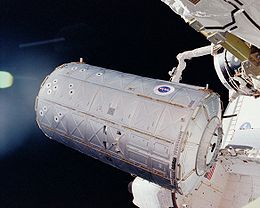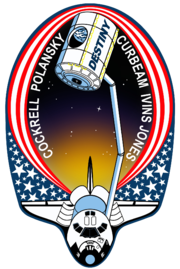
Back STS-98 Arabic STS-98 Bulgarian STS-98 Catalan STS-98 Czech STS-98 Danish STS-98 German STS-98 Greek STS-98 Spanish STS-98 Estonian استیاس-۹۸ Persian
 Atlantis' Canadarm grapples Destiny, prior to the module's installation on the ISS | |
| Names | Space Transportation System-98 |
|---|---|
| Mission type | ISS assembly |
| Operator | NASA |
| COSPAR ID | 2001-006A |
| SATCAT no. | 26698 |
| Mission duration | 12 days, 21 hours, 21 minutes, 0 seconds |
| Distance travelled | 8,500,000 kilometers (5,300,000 mi) |
| Orbits completed | 171 |
| Spacecraft properties | |
| Spacecraft | Space Shuttle Atlantis |
| Launch mass | 115,529 kilograms (254,698 lb) |
| Landing mass | 90,225 kilograms (198,912 lb) |
| Payload mass | 14,515 kilograms (32,000 lb) |
| Crew | |
| Crew size | 5 |
| Members | |
| Start of mission | |
| Launch date | 7 February 2001, 23:13 UTC |
| Launch site | Kennedy LC-39A |
| End of mission | |
| Landing date | 20 February 2001, 20:33 UTC |
| Landing site | Edwards Runway 22 |
| Orbital parameters | |
| Reference system | Geocentric |
| Regime | Low Earth |
| Perigee altitude | 365 kilometers (197 nmi) |
| Apogee altitude | 378 kilometers (204 nmi) |
| Inclination | 51.6 degrees |
| Period | 92 minutes |
| Docking with ISS | |
| Docking port | PMA-3 (Unity nadir) |
| Docking date | 9 February 2001, 16:51 UTC |
| Undocking date | 16 February 2001, 14:05 UTC |
| Time docked | 6 days, 21 hours, 14 minutes |

 L-R: Robert Curbeam, Mark Polansky, Marsha Ivins, Kenneth Cockrell and Thomas Jones | |
STS-98 was a 2001 Space Shuttle mission to the International Space Station (ISS) flown by Space Shuttle Atlantis. It was the first human spaceflight launch of the 21st century. STS-98 delivered to the station the Destiny Laboratory Module. All mission objectives were completed and the shuttle reentered and landed safely at Edwards Air Force Base on 20 February 2001,[1][2] after twelve days in space, six of which were spent docked to the ISS.
- ^ Jergler, Don. 2001. A textbook touchdown–Atlantis pays unexpected visit to desert. Antelope Valley Press (Lancaster/Palmdale, CA), 21 February 2001 issue, pp. A1, A5.
- ^ Welcome Home. 2001. Desert Wings Vol. 53, No. 7, 23 February 2001 issue, p. 1.
© MMXXIII Rich X Search. We shall prevail. All rights reserved. Rich X Search